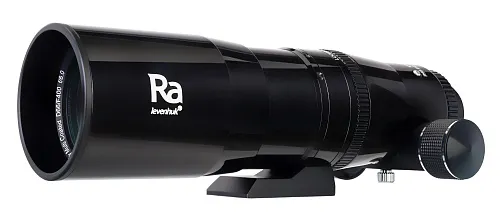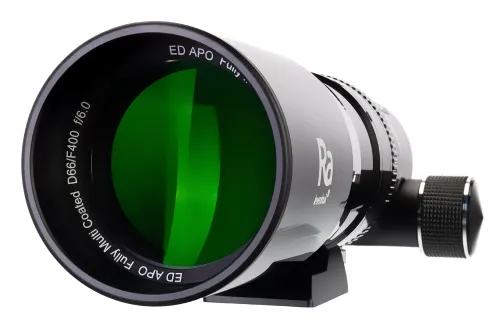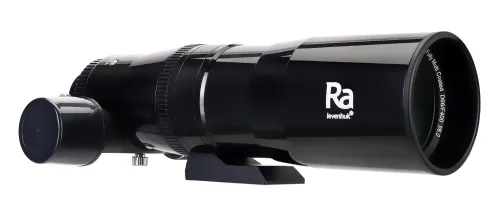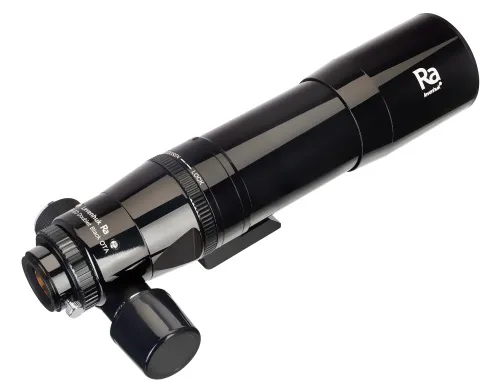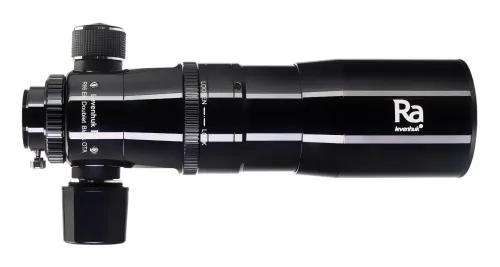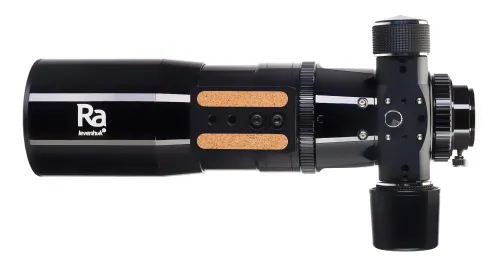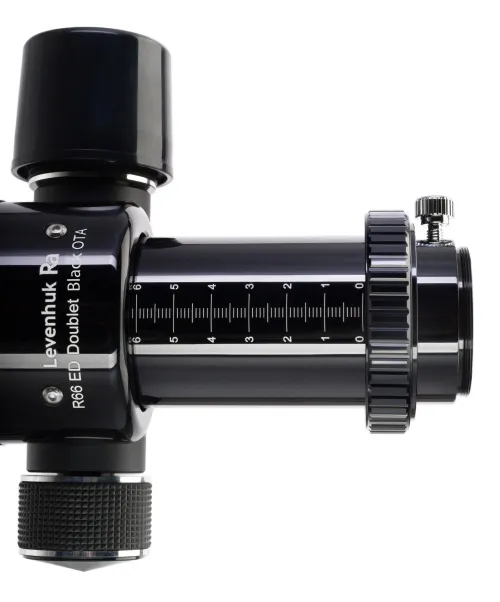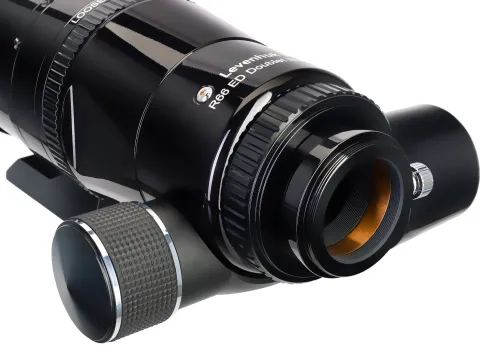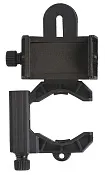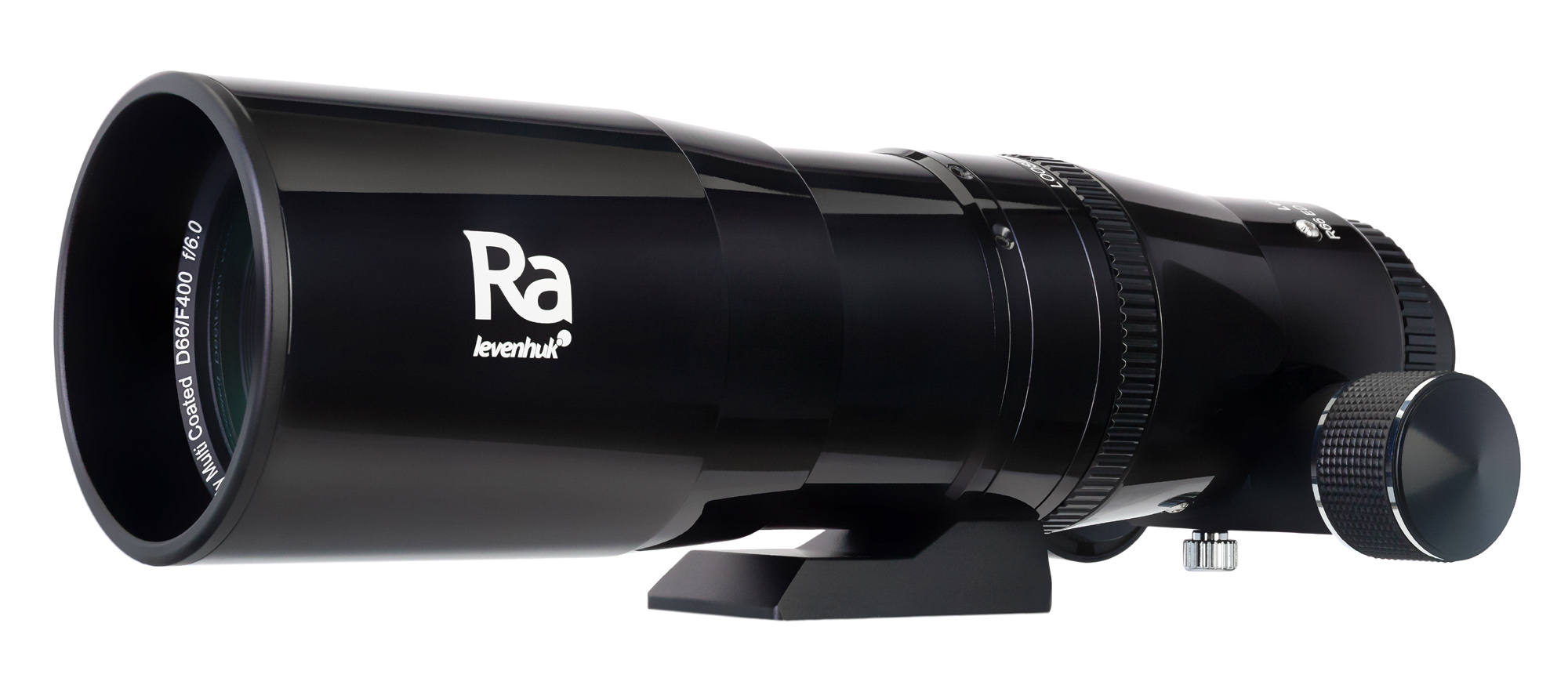Levenhuk Ra R66 ED Doublet Black OTA
Two-lens apochromatic refractor with extra-low dispersion optics. Aperture: 66mm. Focal length: 400mm
| Product ID | 61945 |
| Brand | Levenhuk, Inc., USA |
| Warranty | lifetime |
| EAN | 5905555002576 |
| Package size (LxWxH) | 40x29x21 cm |
| Shipping Weight | 4.37 kg |
The Levenhuk Ra R66 ED Doublet Black OTA apochromatic refractor is a short-focus optical tube that allows for getting an idea of the objects from the Messier and NGC catalogues as well as observe the relief of the lunar surface in detail. You can carry out planetary observations as well as deep sky observations. However, the primary use of this Optical Tube Assembly (OTA) is astrophotography. The pictures taken by this telescope are high contrast and very clear detail.
The lenses are made of extra-low dispersion glass that effectively suppresses chromatic aberrations, especially secondary and spherochromatism. The wide field of view makes it comfortable to study extended areas of the sky. The telescope features a dual-speed Crayford focuser that provides smooth and highly accurate focusing under all conditions.
The optical tube is made of anodized aluminum and can be installed on most modern mounts. As the OTA is quite lightweight and compact, it is a great choice for countryside trips. The kit also includes a convenient aluminum case for transporting and storing the telescope.
Please note: Mount, tripod, and optical accessories are not included.
Features:
- Compact and lightweight apochromatic refractor
- Fully multi-coated glass lenses made of ED glass
- Dual-speed Crayford focuser for precise focus adjustments
- Excellent image clarity and contrast, minimal chromatism
- Excellent choice for astrophotography, good for visual observations
The kit includes:
- Telescope optical tube
- Cleaning wipe
- Aluminum case
- Protective caps
- User manual and lifetime warranty
| Product ID | 61945 |
| Brand | Levenhuk, Inc., USA |
| Warranty | lifetime |
| EAN | 5905555002576 |
| Package size (LxWxH) | 40x29x21 cm |
| Shipping Weight | 4.37 kg |
| Optical design | refractor |
| Optical scheme | apochromat |
| Optics material | ED |
| Optics coating | fully multi-coated |
| Objective lens diameter (aperture), mm | 66 |
| Focal length, mm | 400 |
| Highest practical power, x | 132 |
| Aperture ratio | f/6 |
| Resolution threshold, arcseconds | 1.75 |
| Limiting stellar magnitude | 11.2 |
| Focuser | 1.25", Crayford, dual-speed |
| Telescope control | manual |
| Optical tube mounting mode | quick-release 1/4" thumbscrew |
| Optical tube material | anodized aluminum |
| User level | experienced users, professionals |
| Assembly and installation difficulty level | easy |
| Observed object | planets of the Solar System |
| Pouch/case/bag in set | case |
Convenient diagrams that describe how to install additional accessories on refractors and catadioptric telescopes
Find out how to assemble a telescope on an example of the Levenhuk Skyline 90x900 EQ telescope
This short guide will help you avoid typical mistakes and learn more about telescope and mounting types
The basics of astronomical observations for beginners
In this article we have gathered answers to some of the most frequently asked questions about telescopes
The most interesting celestial objects you can observe with Levenhuk telescopes
How telescopes work?
You can actually perform observations from your balcony!
All about telescope sizes, types, magnification, and mounts
Learn how to set up and use the telescope properly
Astronomy in light-polluted skies. Find out what you can observe in the city
Read an interesting comprehensive article on telescopes for little astronomers
The pictures are made with Levenhuk telescopes
Celestial objects you can observe with telescopes of different apertures
Colored and vivid images of galaxies, planets and star clusters entrance everyone who is fascinated by boundless space
Find an interesting review on the history of the changes to a refracting telescope
To make the process of choosing a telescope easier, we will tell you about the characteristics of the most popular types of telescopes today
Learn everything you need to know about refractor telescopes to make the right choice

